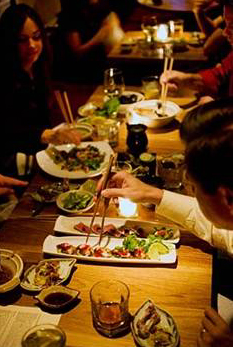Home > Entertainment > Food & Dining > Izakaya Style Story
Imbibing izakaya style

Ben Narasin, Special to The Chronicle
Tuesday, November 13, 2007
You don't have to enjoy the traditional Japanese bar snack of salted squid guts called shiokara to appreciate the tapas-style offerings of Japanese pubs known as izakayas.
They're already flourishing on the Peninsula and in the South Bay, and while they haven't yet captured the heart of San Francisco, new ones are opening, including the splashy O Izakaya Lounge set to debut next week in the newly renovated Hotel Kabuki.
Most Bay Area izakayas serve a relatively wide range of Japanese food. "This is USA. People think Japanese is sushi," says Yoicho Ito, owner of the 3-year-old Izakaya Mai in San Mateo, whose restaurant incorporates a sushi bar. Other Bay Area izakayas, such as Hoshi in Santa Clara, are truer to traditional Japanese versions.
Bay Area izakayas also vary widely in atmosphere. In Mountain View, Nami Nami's soft lighting and music provide an intimate setting for a couples' night out. The sunken tatami mat tables at Gochi Japanese Fusion Tapas in Cupertino are great for groups or a family. At the other extreme, San Francisco's Nihon Whiskey Lounge exemplifies a drinks-focused vibe.
In Japan, izakayas are typically sake pubs that offer small plates meant to be shared while drinking. Originally, they catered to Japan's blue-collar workers (which usually didn't include women) as after-work drinking destinations.
More recently, the pubs have become popular with students, travelers and the working class of both genders. Izakayas are sometimes called "red-lantern restaurants" because they're commonly identified by garish red paper lanterns hanging in the doorway. Many also display statues of Tanuki, the mischievous shape-shifting "raccoon dog," who, like a Japanese leprechaun, is a trickster out to deprive revelers of their sake.
Izakayas' appeal is seasonal foods cooked correctly and uniquely garnished, and their popularity in Japan and other regions where they're taking hold stems from a wide selection of inexpensive food and drink, and a casual communal atmosphere. Formats range from tiny, six-seat locations filled with neighborhood locals to corporate chains, train station quick stops and multi-floor emporiums pulsing with music. Drinking is the unifying theme, with the food as a complement.
In Japan, each type of food - tempura, sushi, yakitori and the like - merits its own restaurant. Even eel has its own spot. In the Bay Area, however, izakayas are often hybrids. They might have sushi bars to complement traditional offerings, or they take a self-described "fusion" approach that incorporates other Japanese specialties or marries Eastern and Western offerings.
Americanized versions of izakayas lean toward tapas style, emphasizing food eaten rather than sake sipped. "Izakaya style is most(ly) appetizer(s)," says Ito. True to the traditional seasonal approach, he says what's fresh in the market determines what's offered. "Every day you come in (there is) something new to try. Every day something special."
Izakayas have gained some ground in North America, outside of the Bay Area. Vancouver is an izakaya hot spot, while New York and Los Angeles have their fair share. P.F. Chang's corporation even opened an izakaya-styled prototype in Scottsdale, called Taneko. "Consumer reaction has been fantastic," says Taneko's development partner and chef Paul Muller. However, he adds, diners are "a little confused about what we are at first." Still, Taneko has "lots of potential for the future," he says.
When Naomi Koda, who owns Saizo in Sunnyvale, moved from Japan to the Bay Area in 2000, she says she couldn't find a restaurant where she wanted to go, because "most American entrees (are) too big and appetizers (are) too huge and (you) can't try many things." So, four years ago she opened Saizo as a "Japanese tapas and sake" eatery. Now Saizo is bustling, and at least one other izakaya has opened nearby.
Izakayas may be more prominent in the South Bay, but they seem to draw diners from throughout the Bay Area. Ito says at first his customers were locals, but now a lot of his clientele are people who have traveled to Japan, where they frequented izakayas. San Francisco accountant Nicole Chen, a neighboring diner on my recent visit to Gochi in Cupertino, says she loved eating at an izakaya restaurant in Japan, and now makes a pilgrimage to Gochi once or twice a month for its creative food.
Chen thinks izakayas might be slow to take hold because "in Japan, an izakaya (is) a place to hang out with friends," while "in the Bay Area, bars and clubs are identified with socializing."
Cultural translation may present less of a problem than literal translation. When I lived in Tokyo, it was a constant challenge to convince servers and chefs that a gaijin (foreigner) could appreciate their unique foods. I find the same reticence in many traditional izakayas here. If you can't read kanji, the Japanese calligraphic alphabet, and you're not willing to order and eat the salted fish stomach called shuto for street cred, you need to talk with the regulars.
On my visits to izakayas, neighboring diners gave me inside tips on off-menu goodies, translations of seasonal items that didn't make the English menu, and occasionally invited me to share a dish. At Oyaji in San Francisco, San Francisco venture capitalist Jae Lim introduced me to hamachi kama, or "collar," of the yellowtail, what he described as his favorite "truly authentic izakaya food."
While other diners' tips can be useful, izakayas are all about trying a range of creative dishes. A few people ordering a few things apiece create the classic izakaya model - shared food, drinks and camaraderie. It's a communal approach to food and drink that gives izakayas a congenial, sometimes boisterous, atmosphere - and that has global appeal.








